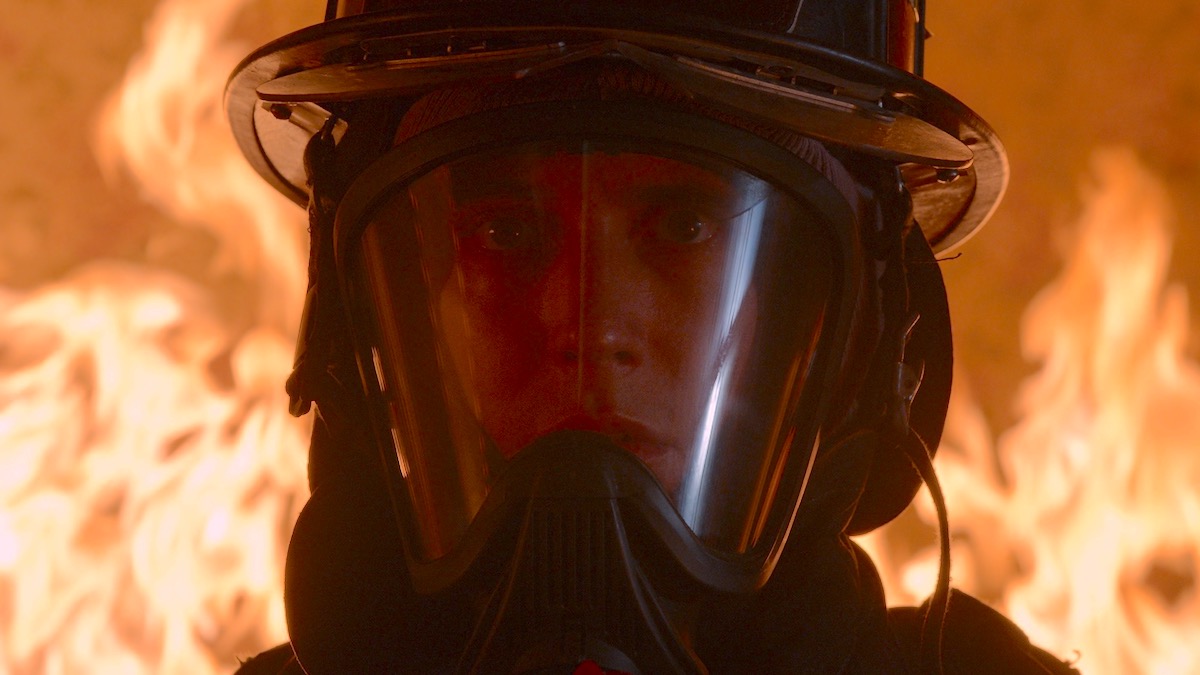Novelist Rodes Fishburne’s new series, Paradise Lost, for Spectrum Originals is a rich, Southern slow burn in front of the camera, and a path toward inclusivity behind the lens.
by David Geffner / Photos and Framegrabs Courtesy of Paramount Network / Spectrum Originals
When Director of Photography Alan Caso, ASC, whose many years lensing episodic television include four Primetime Emmy nominations (Into the West, Six Feet Under and George Wallace) and acclaimed shows like American Gothic and The Americans, signed on to shoot Paradise Lost, a new drama for Spectrum Originals, his first ask was that his alternating director of photography be female and/or a person of color.
Why? Because as Caso reflects: “The biggest change for me [in crewing up a show] has been to identify unconscious bias, and work against that to create a more fair and diverse industry, and honestly, a much better product,” he states. “To be surrounded by people who have shared a similar or even identical life experience puts you in a very narrow place of creativity and world view. An inclusive crew opens up new artistic sensibilities and an entire range of voices; it’s the difference between playing a piece only with the middle-C octave as opposed to the entire keyboard. To deny all those notes is the antithesis of creating real art and telling important stories.”
Caso’s mandate was fully supported by Paradise Lost’s creator, novelist Rodes Fishburne, and co-executive producers Mark McNair (also the 2nd unit director), David Kanter, and Local 600 Director of Photography turned Producing Director Romeo Tirone.
“We threw out a very wide net and ultimately landed on Nicola [Daley, ACS], who has worked a lot in Australia and the U.K.,” Caso continues. “We were very impressed with Nicola on that first Skype call. [Daley is based in London.] Her reel [and her website] show a taste in lighting and composition that’s on par with what we were going for with Paradise Lost, which is set in a small town in the South, where the heat, humidity, and texture had to seep right into the filmmaking.”
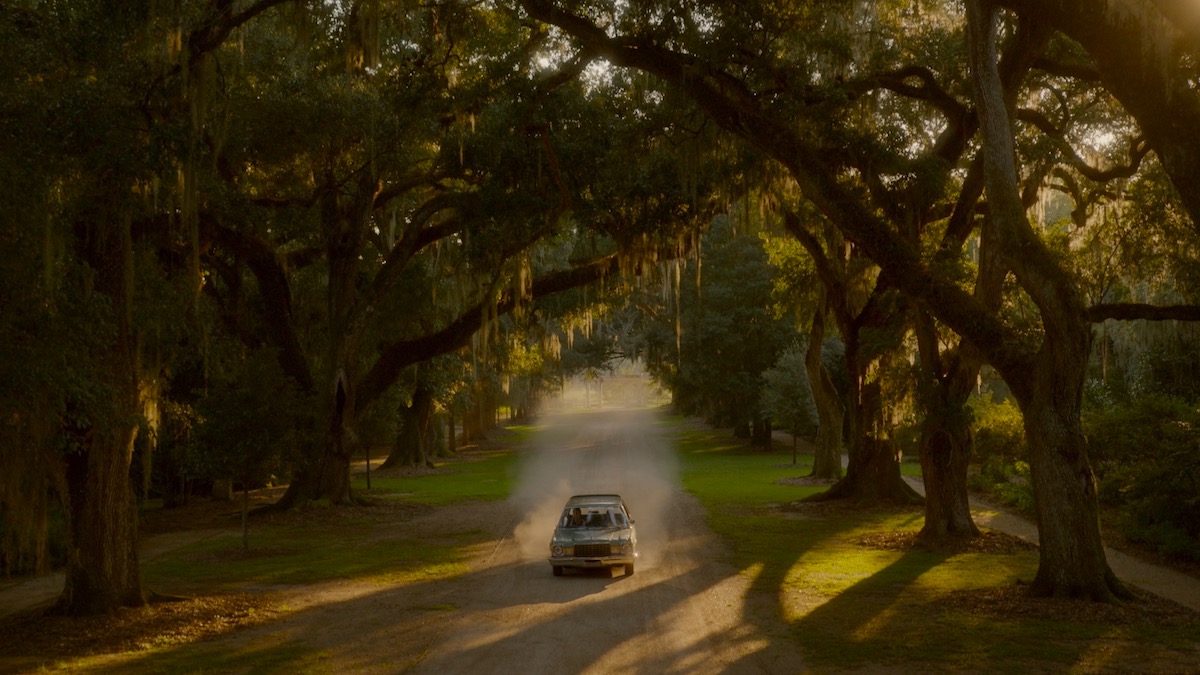
According to Caso, Daley’s work also showcased an ability to “beautifully model faces, and keep the lighting simple, sourced and natural,” he continues. “While her compositions are evocative and asymmetrical, with good use of negative space, she’s also not afraid to center-punch as a choice. Probably the most important thing, aside from her easy-going personality, is that I could tell that Nicola knew how to use wide lenses – a prerequisite when working with me.”
Fishburne, who describes Caso as a “highly infectious collaborator,” says the veteran lenser came up with “five different ideas at our first meeting, so we all knew Alan was a perfect fit,” he offers. “What was so wonderful about Nicola is that she hasn’t spent a lot of time in the South. She brought a fresh, outsider’s perspective to a place where I was born and raised. For me, that was key to creating a tone that didn’t mirror the many depictions of the South we’d already seen. My question was: ‘How do you make sure that Southern Gothic tone—as one character in the show says, “Nothing is more alive in the South than the dead,”—doesn’t come off as one-dimensional?”
One way Fishburne achieved that goal was by injecting what he and Caso called “Vitamin C” into the frame, “with the C representing color,” he adds. “And Nicola’s fearless when it comes to trying unexpected color palettes. Her approach is based on her personal experiences, which owed nothing to how I saw Mississippi, and that was a good thing. I would also add that as a showrunner, shooting in 90-plus degrees in Baton Rouge, Louisiana in August, you quickly discern the true professionals. I would consider myself lucky to work with Alan and Nicola again. They were amazing.”
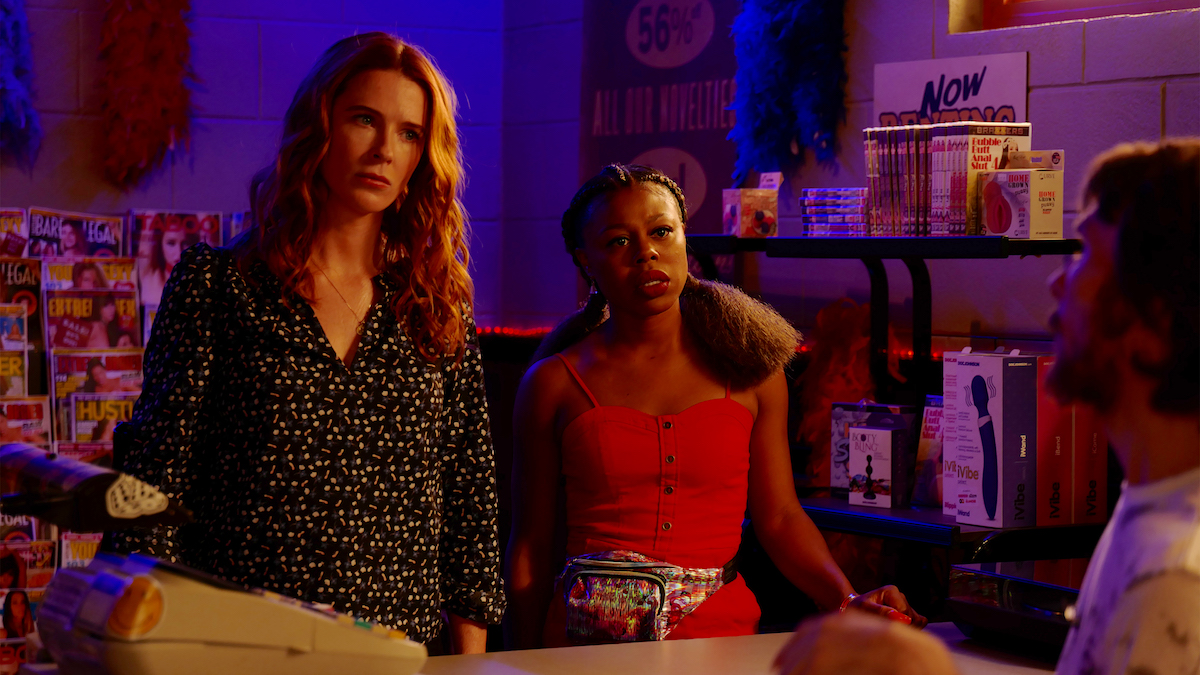
Amazement (mixed with some trepidation and awe) was how Daley (Harlots, The Letdown, Pin Cushion) approached her largest-budget project to date, which included a camera crew she’d never met and her first-ever use of the Sony VENICE full-frame capture system. Of course, when it came to Caso, she already knew she had an ally.
“Alan’s speech at the ASC awards had gone viral among many female cinematographers, so he was already famous in my mind,” Daley recounts. “The speech [about inclusivity in hiring film crews] had a huge impact on our community and was a true beacon of light. While the numbers of men and women coming out of film school may be relatively close, the actual percentage of female directors of photography [in the U.K.] is only six percent, so it’s a war of attrition, and I get that. When I was starting as a camera assistant in Australia, I endured all kinds of comments, things today we call ‘micro-inequities’ and ‘microaggressions.’ This systematic chipping away of a person [because of their gender or race] means that the micro eventually becomes the macro, and the behavior, if unchecked, feeds into the film and TV culture as a whole. This is what needs combating every day, and why a person like Alan is so vital to creating change.”
Shooting in the U.S. was not the only first for Daley, who says the size of Paradise Lost’s sets, the approach to lighting them, and the use of slant focus lenses were all new. “I hadn’t used [slant focus lenses],” she adds, “and Alan shared his learning curve in terms of movement of the actors, and what you can feasibly get away with within the plane of focus. As a cinematographer, it does no good being a closed shop. If we’re open and free with our creativity, then everyone becomes a better artist, and [crews] are inspired along the way. Cinematography is a craft you keep learning throughout your career. That’s what keeps me excited every day to go to work.”
What also kept Caso and Daley motivated was Fishburne’s desire to “let the story breathe,” and play scenes in long takes. “Neema Barnette, who directed my first episode,” Daley relates, “fought to maintain the style [pilot director] John Lee Hancock had established with Alan, which didn’t pander to all the typical over-the-shoulders and coverage so many TV shows want to live in. The flashback scenes, for example, are a nice instance of shooting outside the box.”
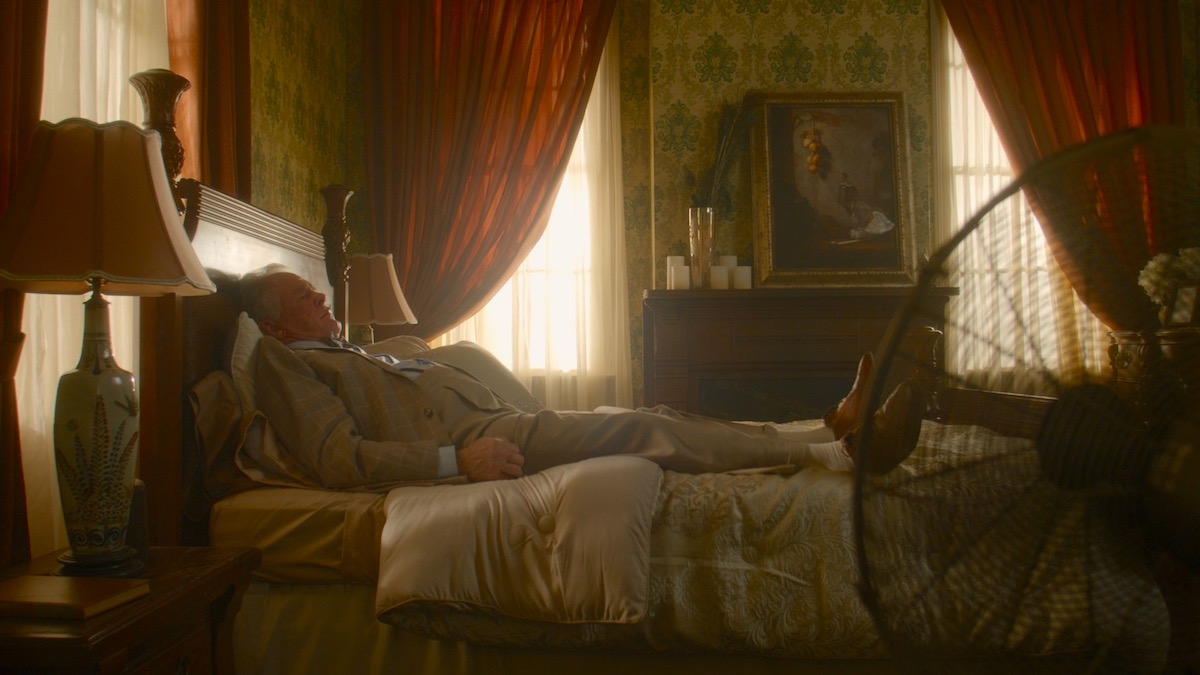
Paradise Lost centers around the return of hometown high school football hero Yates Forsythe (Josh Hartnett) and his family, wife Frances (Bridget Regan) and sons Reynolds (Jackson Tessmer) and Davis (Michael Kendall Kaplan), to Bishop, MI, after a failed stint as a Palo Alto, CA entrepreneur. Yates comes back to run his father, Judge Forsythe’s (Nick Nolte’s) fading newspaper, Southern Trees, while living in the guest house belonging to Judge and his mother, Byrd (Barbara Hershey), with a steamer trunk full of dark, violent secrets.
At the heart of the puzzle box (and the source of most of the flashbacks) is Judge’s deceased daughter, Janus (Autry Haydon-Wilson), who lorded over a teenage Yates and his best friend, Dickie Barrett (Shane McRae), in a barn/art studio filled with her psychosexual, deeply metaphoric oil paintings. When Frances, a psychologist, sets up shop in Bishop and hears the “strange visions” of her first client, Boyd Suttree (Silas Weir Mitchell), secrets begin to unravel, propelling each successive episode like a nesting doll whirling out of control.
“One of the things we were adamant about with all of the interiors, but particularly with Janus’ art studio,” Caso recalls, “was creating the feeling that the environment was pushing into these people’s lives – heat, moisture, humidity, and bright sunlight. So for the barn set, I had the art department widen all the wooden slats to let in more light. Whenever we could, we’d have one of our big lights in the shot to appear as the sun. Nearly everything was shot on sets save for a few key locations.”
Daley says those included the house where Janus’ favorite painting, Mississippi Ophelia, hangs. “Our production designer, Meghan Rogers, built a lot of practical lights into the location and dressed the room where the painting hung in a fantastic style,” Daley recalls. “I truly think our craft is so reliant on that creative give-and-take with the production designer. It’s such a key relationship these days.”
Fishburne also credits producing director Romeo Tirone, whose background as a Local 600 cinematographer helped protect the texture and breathability Fishburne sought for the show’s look. “When you’re riding on a covered wagon across the country, you need to be careful who’s there with you,” the first-time showrunner explains. “Romeo is one of those guys who is a problem-solver; he would help brainstorm with Alan, Nicola, Meghan, the whole creative team about the best way to surmount any obstacles in our path.”
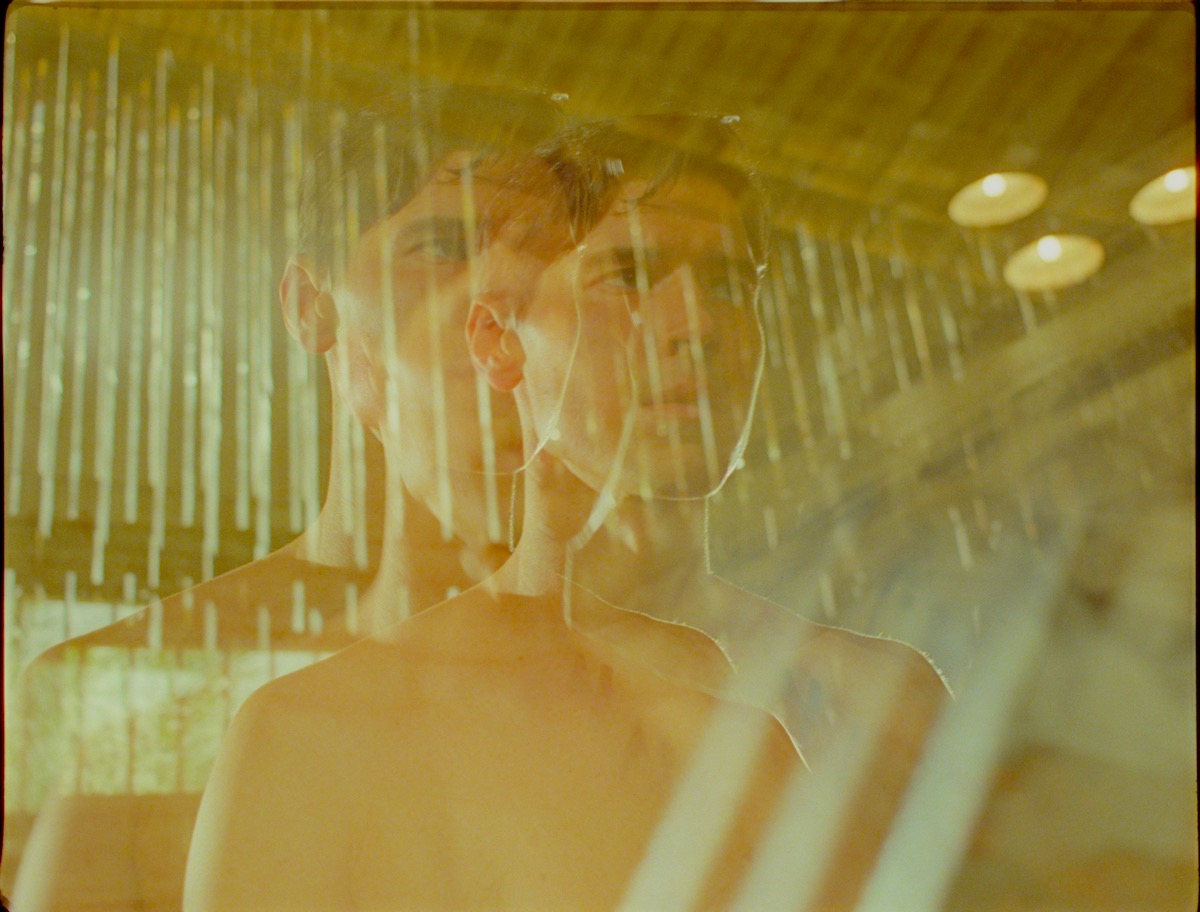
Some potential bumps, like the flashbacks Daley referenced above, turned into speedways that were later embraced in editorial as standout narrative moments. Caso says the flashbacks skewed toward saturated pastels “rather than the more common desaturated look we often see,” he offers. “Our colorist, Maxine Gervais at Technicolor, brought a lot to those scenes, as the flashbacks varied throughout in density and saturation.”
Many of the flashbacks come abruptly with an overlapping, frenetic quality that Daley says owed “to us shooting those scenes in 35-millimeter film with an ARRI IIC. We would hand-crank and dolly forward, then stop and crank back to repeat and overlay,” she reveals. “The technique originally was a memory trigger to get you into the character’s head, but the editors loved it so much it was used throughout those scenes. Every time we began to shoot the flashbacks, the operators would get excited seeing the film cameras come out.”
As for shooting on Sony VENICE, done, in part, to fulfill Spectrum’s mandate for a native 4K deliverable, Caso says he’s typically not a fan of false color. “But the VENICE allows you to go into the camera’s programming and assign colors to different areas of the exposure,” he explains. “I knew we’d be doing a lot of setups and not have time for a DIT tent and video village. So to quickly establish an exposure level, I set the green color to 38 to 42 percent, eliminating all the other colors and making the only false-color my calculated green. Then I would find something that I felt was a middle gray and iris until that object was green to find my exposure value. It was sort of like having an in-camera light meter.”
Daley, who had tested the VENICE for a show in Australia (but was not able to use it due to the project’s budget limitations), says Sony’s new capture system “renders skin tones beautifully. We softened it with Hollywood Black Magic diffusion to give the image the texture and weight Rodes wanted.”
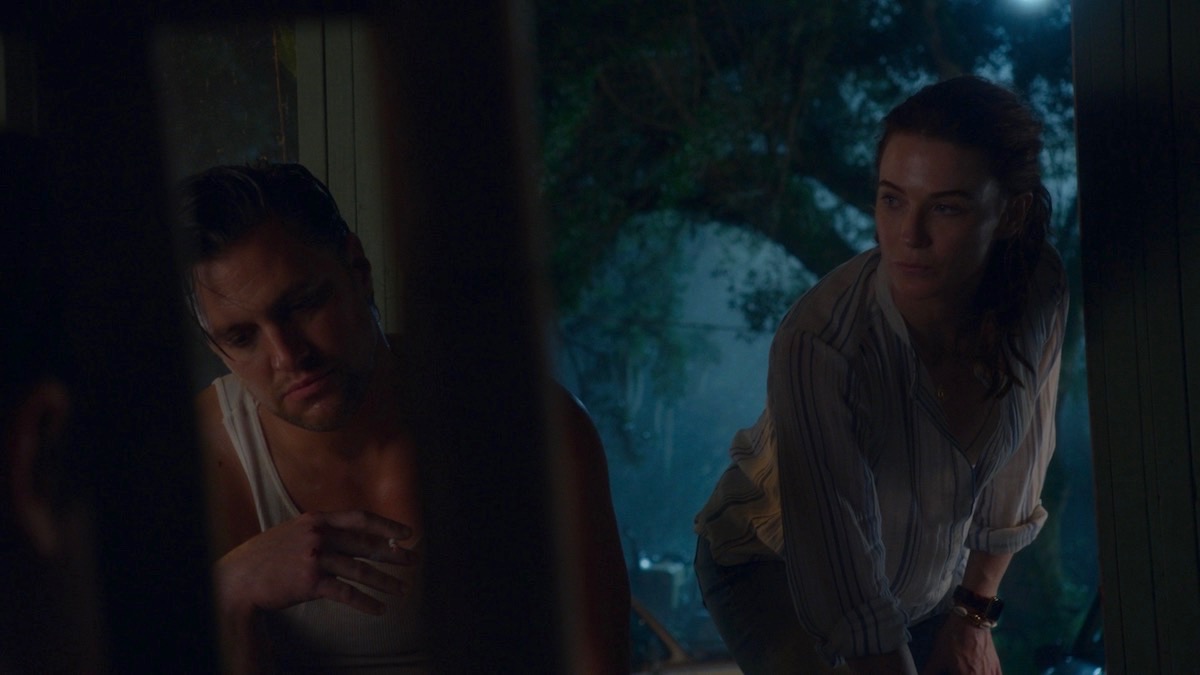
One of Paradise Lost’s key moments that’s filled with the Southern atmosphere Fishburne was seeking concludes Episode 8 – shot by Daley – and opens Episode 9 – shot by Caso. The extended night scene begins inside the vestibule of Boyd’s ramshackle home on Dickie Barrett’s property and then moves outside to a moonlit pool nearby, where Yates finally reveals his past to his wife. It’s a prime example of what Daley describes as “two cinematographers collaborating” across a series, “which, believe it or not, in our industry doesn’t happen all that often,” she observes.
The Episode 8 ending, steeped in shadows and checkered with fiery reds and oranges, is a final severing of Yates’ and Dickie’s friendship, forever damaged by Janus’ manipulations of their lives as teenagers. Yates puts a rifle to the head of his friend, who challenges Yates to either “pull the trigger or tell Frances the truth.” As Daley explains, “I wanted the lighting ratio to be high and the contrast to be a character, as it’s a major unraveling of all the secrets and dark memories that have been hinted at in previous episodes. Boyd’s location has several layers, so I put light in the depth of the building behind them. It’s volatile and the lighting needed to reflect that.”
Daley discussed running bug lights with Chief Lighting Technician Kurt Pomerleau around the eaves of the house outside that would provide a sickly yellow cast. “We made one of those insect lights flicker to enhance the feeling everything was breaking down,” she continues. “I also changed Alan’s moonlight package slightly from a plus green to a white flame green to get a dirtier quality. I’m always looking to create planes of depth with color, which can be a bit subconscious for the viewer, but I love using color in that way.”
Caso layered the exterior of Suttree’s home as well, using areas of shade and silhouette to recess lighting elements, one deeper than the other. “I hid the main key backlight partly behind a tree, so you’d feel this creeping moonlight. The opening shot in Episode 9 is a pan-up from this algae-ridden swimming pool to the reflection of the moon, which is just a light. The crazy thing – when I watched that episode – is I realized there were two moons out that night,” Caso laughs. “One looking toward Boyd’s house, and then another when you turned around. I didn’t realize our planet had two moons!”
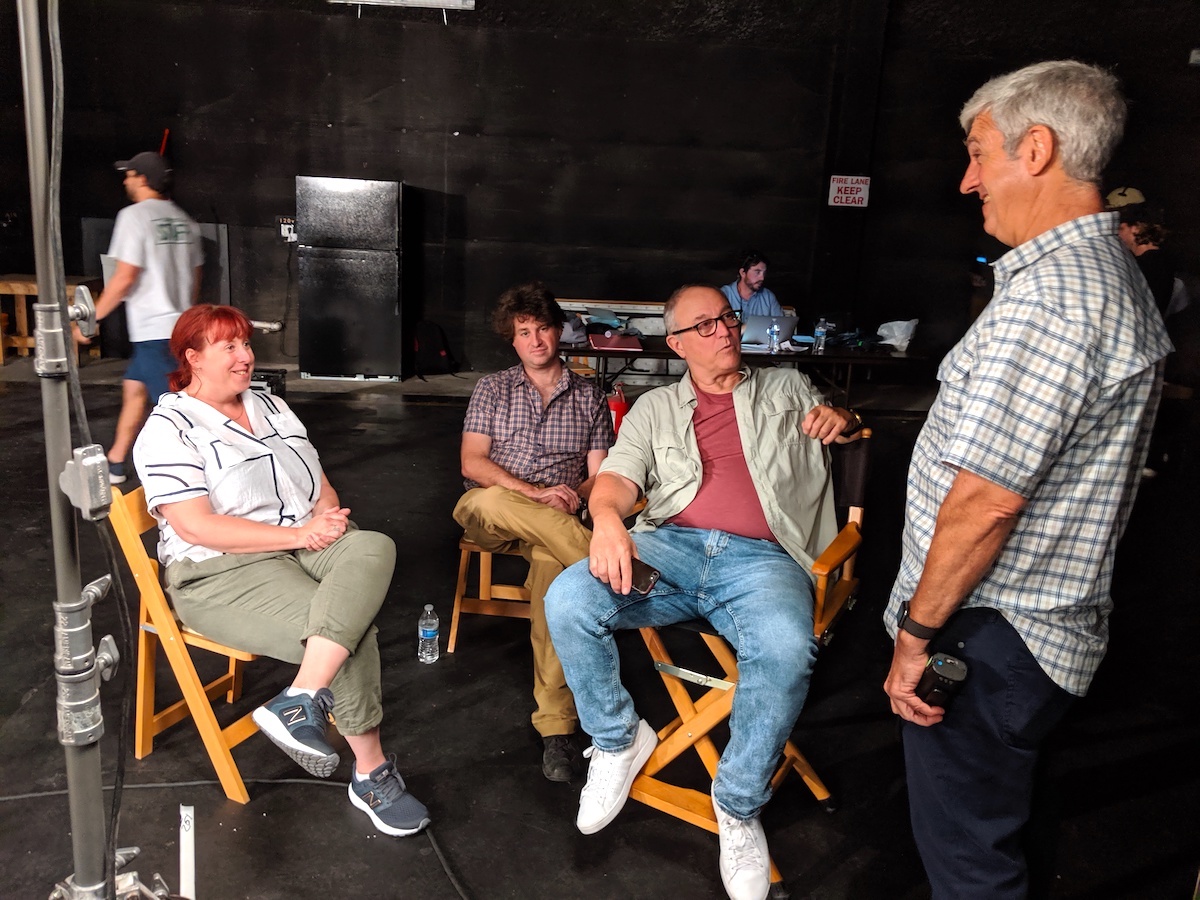
Such self-deprecation and humility are typical of both directors of photography, who were each quick to praise the other’s talents and leadership qualities in interviews for this story. They also lauded their Local 600 camera team, which included A-Camera/Steadicam Operator Luke Rocheleau; A-Camera 1st AC Chris Flurry; A-Camera 2nd AC Bryce Marshall; B-Camera Operator/Splinter-2nd Unit Director of Photography Steven Parker, SOC; B Camera 1st AC/B Camera 2nd Unit Operator Lisa Lengyel; B-Camera 2nd AC Nancy Piraquive; Loader Michael Reynolds and DIT Earl Fulcher.
Daley’s self-effacing nature went so far as to immediately tell Pomerleau and Key Grip Jerone Orden, when she first arrived on set, that “because the system is different in the U.K. [in that the grips’ responsibility lies in the movement of the camera only; they don’t set diffusion and flags, et cetera], I said, ‘I’m going to tell you to do the wrong thing, so please excuse me if I get mixed up,” she laughs. “The whole crew was so supportive – I sat down with the operators before shooting my episodes to show them inspirational photos. I’m a big believer in using everyone’s brain on set to come up with a team vision. I’m the team leader, but my job is also to inspire everybody to do their best work.”
Fishburne says the approach Daley describes was enabled by some “terrific location scouting, where we were able to find places like Clinton, Louisiana , that had not been shot out,” he shares. “Job number one was ensuring that when you watched this series, it could not have been done in any other place but the deep South. For example, the scale and scope of the huge mural Janus had painted on Main Street was important to this story, and Alan and Nicola captured that in such a powerful way.”
Also important is the mystery of the death of two young women after leaving Bishop’s debutante ball twenty years prior. The cause of death was listed as an accident, with their car being hit by a train as it stalled on the tracks. But Frances and her assistant, Gynnifer (Gail Bean), have other theories. So they go out one night to investigate rumors of the ghosts of the “dead debutantes” and are terrified by an intruder. (It turns out to be Dickie, who rushes at them with his weapon.)
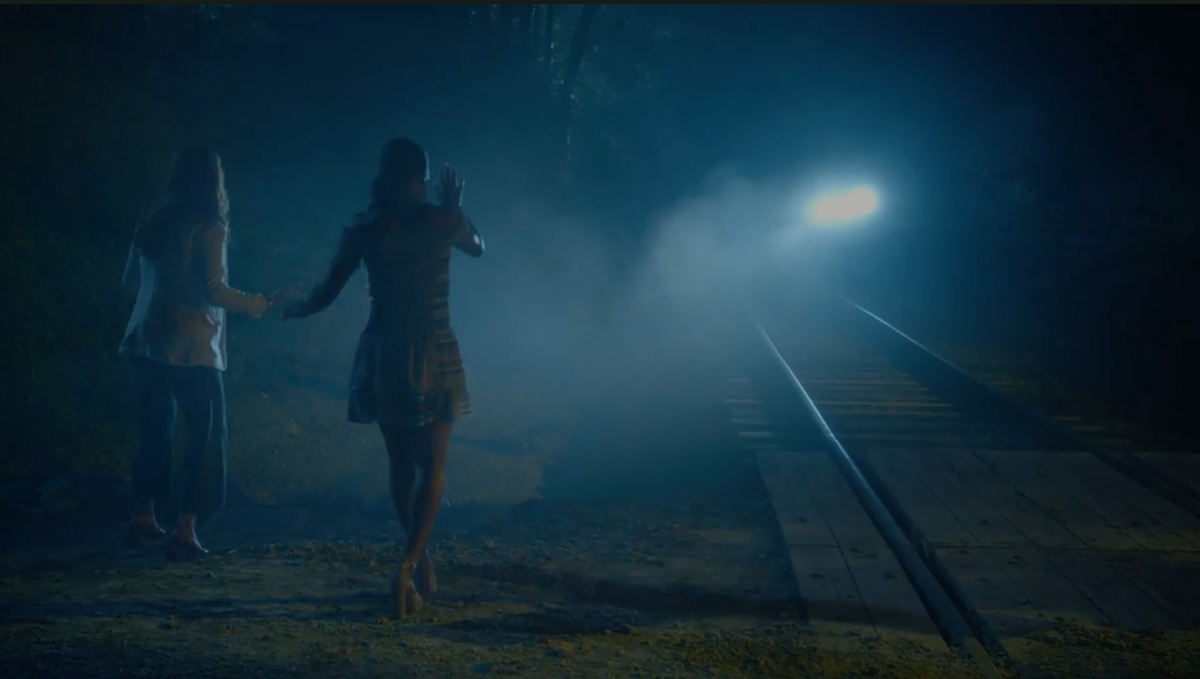
“We wanted to play the railroad tracks as an important motif in that scene,” Daley recalls, “so we had a cherry-picker at the end of the tracks with an 18K backlighting the tracks and our actors. Neema [Barnette] and I talked about having the railroad tracks fade off into the darkness, like they go on forever to create this sense of mystery. That scene, too, has a color/contrast idea for me with the sodium vapor three-quarters backlight in contrast to the silvery green moonlight. All of the night scenes have smoke and humidity in the deep background – real moisture – that glazes the air.”
Daley adds that the diversity of her Louisiana-based production crew was broader and deeper than her experiences overseas. “I think America is making a big push to make their crews diverse, and that’s highly commendable,” she reflects. “It is something I could see just walking on the set of Paradise Lost. It was a visible change that was immediately apparent. Unfortunately, it’s not been so apparent in the U.K., where we pay lip service to the notion, but the actual diversity of a typical crew is changing very slowly.”
Daley had two female directors on the show (Barnette and Elodie Keene), as well as a veteran female 1st AD, Jessica Pollini, whose TV credits include Boardwalk Empire, Vinyl and Yellowstone. “So my first day on the job there are women in key creative and logistical positions all over the set,” she smiles. “And I thought, ‘This is fantastic.’
“Everyone kept calling me ‘ma’am’ because it’s the South,” Daley continues, “and I said, ‘You can’t call me that! ‘Ma’am’ is only for the Queen! I told everyone to just call me ‘Guv’nor,’ which is kind of a silly British joke, and from then on that was it. Everyone called me ‘Guv’ with these fake British accents, and we got on like a house on fire.”
Caso says the process – the workflow of filmmaking – doesn’t discriminate between gender or race, “as it’s the same camera, lights, and dolly for everyone,” he laughs. “What is different is when those voices who have been muted or not heard from for so long, like those of women and people of color, are brought into the process in equal measure, the flower from that filmmaking bloom is more enriched. It’s bigger and deeper because the pool now includes people with many different life experiences and different sensitivities as artists. And that’s certainly what we had on Paradise Lost.”
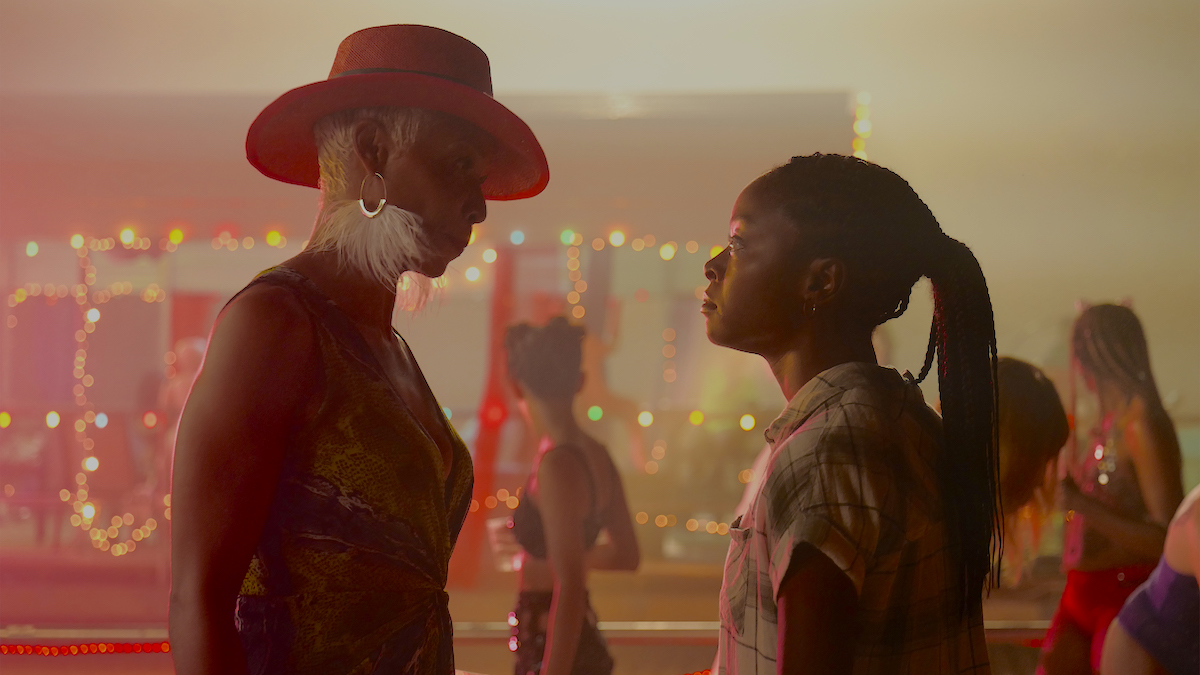
While Daley says she learned a lot from Caso’s extensive years in the TV trenches, Caso is quick to credit his counterpart for expanding his chops. “Having come up in the 1970s and 1980s, I’ve always been that John Frankenheimer-desaturated guy, with this grim view of the world,” he states. “But right before Paradise Lost, I shot the pilot for the reboot of Roswell, and [creator] Julie Plec wanted tons of color and all long lenses. Working with Nicola, I learned to trust my instincts with bold colors. The scene on Poochie ’s houseboat, where [Southern Trees reporter] Nicque [Danielle Deadwyler] gets caught up in a water patrol raid, is a good example, as are the scenes inside Claude’s [Jason Davis’] Adult Book Store, where Frances is given tapes Claude made with Janus. If not for Nicola, I doubt I would have gone as far as I did [with color] in either case.”
Daley’s love for breaking convention wasn’t only confined to color. For a scene in a Memphis motel room, where Yates and Dickie spend a drug-addled weekend, she used a rig grips had built to house a Sony a7S from Hartnett’s bodycam-like perspective, à la ASC member Matty Libatique’s work in Requiem For A Dream. She also convinced Keene to let her wave pieces of an old chandelier [which Daley travels with ] in front of the camera to simulate the hallucinogenic trip Yates and Dickie were experiencing.
As for improving inclusivity in hiring, Caso says that when he came to Hollywood in the 1970s, the term wasn’t on anyone’s radar. “The biggest hurdle I had was not being the son or the brother of someone. I got in during an open season as an operator, so I was further vilified. But I was a young white guy and the jobs eventually came, and I took advantage, helped along by white privilege. That’s not even close to what people of color and women have to endure today. I admire and applaud those [marginalized union members] for breaking through the barrier, and I truly understand their reticence in not wanting to ‘stick their necks out’ and jeopardize their positions by being loud voices for change.
“It’s now up to those with hiring power,” Caso concludes, “like Rodes Fishburne, Mark McNair, Romeo Tirone and me – basically white men in positions of power – to create the momentum that will change the status quo. Once that has happened, those reticent union members can shed their token roles and safely contribute to the advancement of prospective members currently marginalized.”
Fishburne, who echoes Caso, says working with talented, collaborative artists like Caso and Daley was like “discovering, every day on a creative level, that one plus one equals three. As a novelist I’m used to putting together a jigsaw puzzle, alone in a room, trying to figure things out. It’s wonderful and great, but you don’t get the feeling I got on Paradise Lost that people of the caliber of Alan Caso, Nicola Daley or Romeo Tirone are lifting the material to another place altogether. Doing a TV show is more like a crossword puzzle, where the group works together to solve all the problems. I found that aspect of making Paradise Lost so rewarding.”
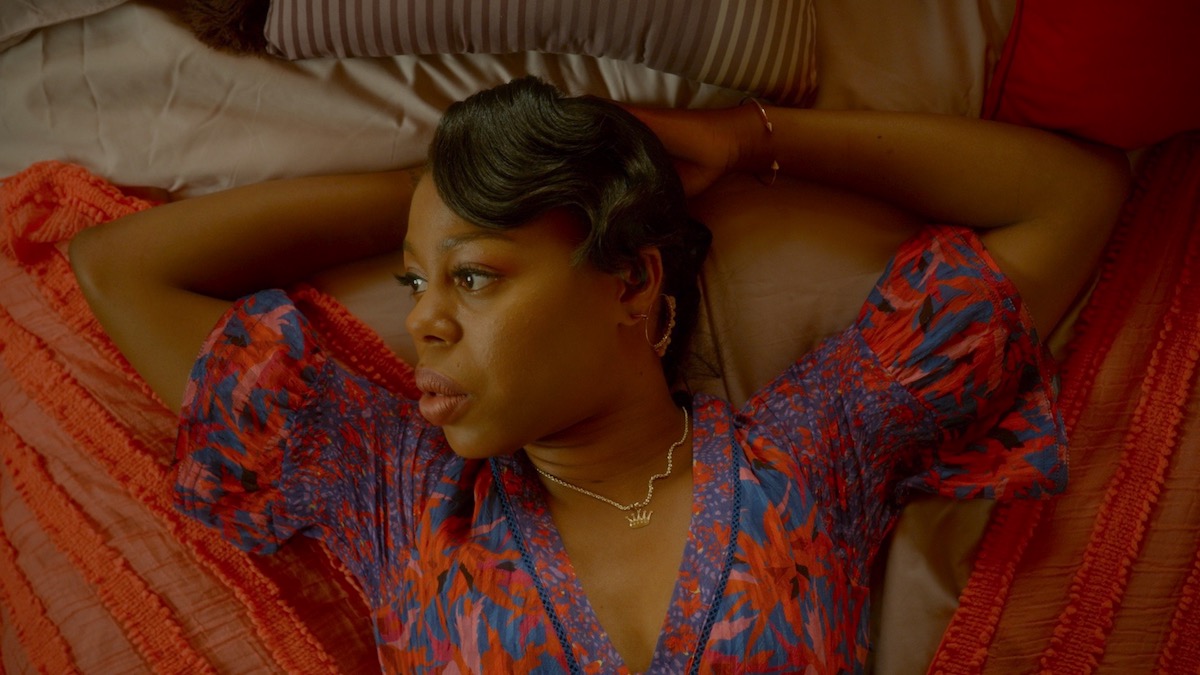
Paradise Lost – Local 600 Crew
Dir of Photography (Ep: 101, 102, 105, 106, 109, 110): Alan Caso, ASC
Dir of Photography (Ep: 103, 104, 107, 108): Nicola Daley, ACS
A Camera/Steadicam Operator: Luke Rocheleau
1st AC – A Camera: Chris Flurry
2nd AC – A Camera: Bryce Marshall
B Camera Operator/Splinter-2nd Unit Dir of Photography: Steven Parker
1st AC – B Camera / Operator B Camera 2nd Unit: Lisa Lengyel
2nd AC – B Camera: Nancy Piraquive
Loader: Michael Reynolds
DIT: Earl Fulcher
DUT: Emmett Crockett
Unit Photographer: Eliot Brasseaux
